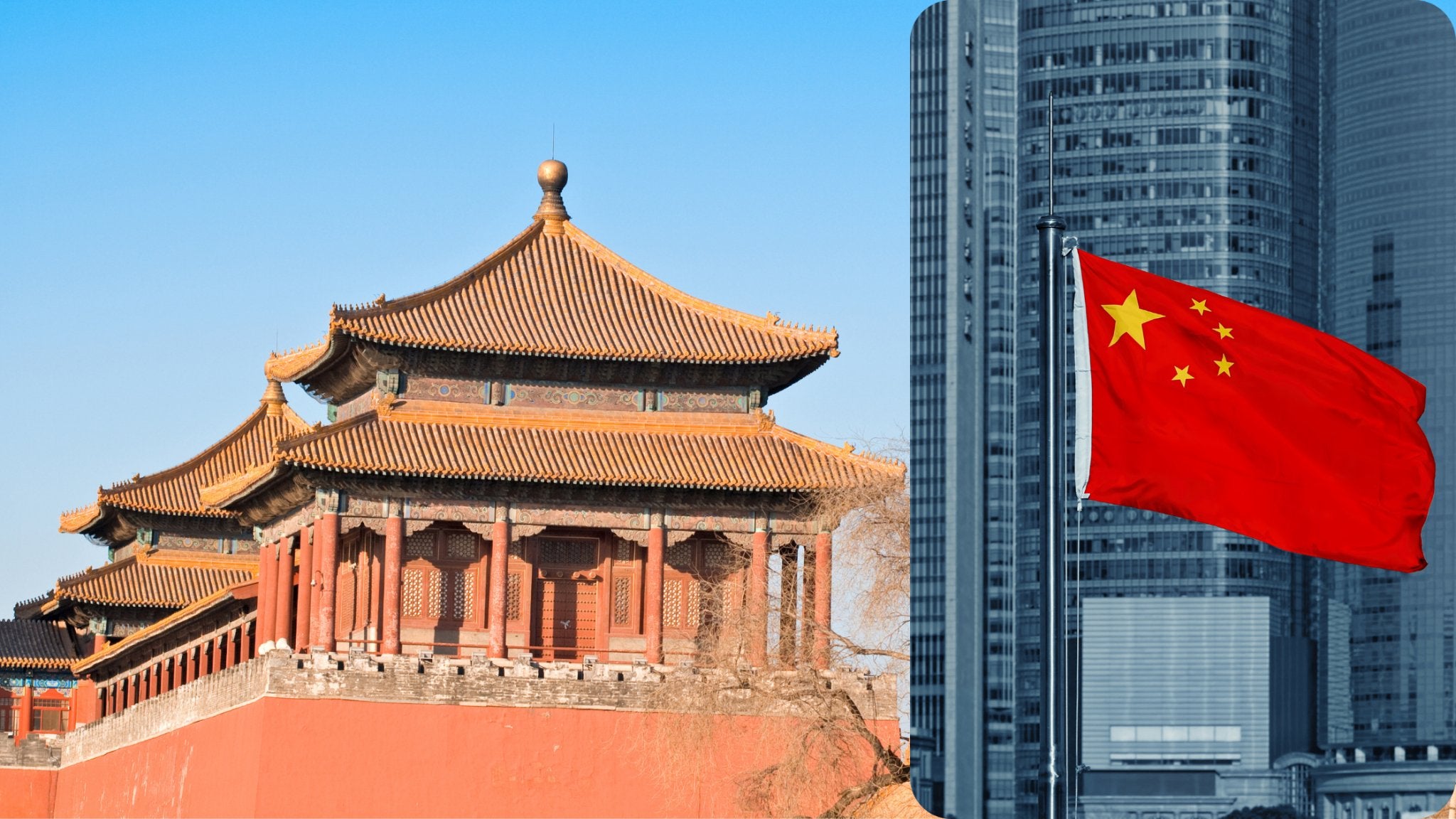China is said to be the world’s oldest of the four ancient major civilizations. It’s been around for a very long time!
Recorded history in the country of China goes back to 1,600 BC/BCE. That’s just what was written down. People have been living in the area known as China since prehistoric (before recorded history) times.

Archaeologists found villages which date back to 5,000 BC/BCE around the Yellow and Hunan rivers. They find all sorts of things when they start digging around, like pottery and ancient tools and skeletons!
Then the scientists run tests on the unearthed items to figure out the age. That way they can tell roughly when a place was inhabited and how the people lived.
From Primitive Villages to Ruling Dynasties
Before 1,600 BC/BCE, the history of China was mostly legends and mythology. Prehistoric evidence has shown that people lived in small farming communities. These little villages were made up of around 100 people or so.
Eventually, these groups of villages combined their efforts and resources and became the first dynasty of China.
A dynasty is a ruling family. One family is chosen, or takes over leading a group of people. Once they are in charge, the leadership role is passed on through the family. Sons or daughters become the leaders as the family goes on. If a different family comes in and takes over, the dynasty changes.
Let's explore some of the dynasties of China and the awesome inventions they contributed! How many inventions can you spot below?
The Xia Dynasty
The first dynasty in China is thought to be the Xia Dynasty. This was before China’s history began to be recorded, so not a whole lot is known about it. Much of the information comes from what archaeologists have unearthed and from stories and legends.
The Shang Dynasty - Writing, Silk, and Metalworking
The next ruling family was the Shang Dynasty. The Shang dynasty ruled in China from about 1,600 BC/BCE to 1046 BC/BCE.

They were the first civilization in China to develop a form of writing, which is similar to modern day Chinese writing. Their writing provided them with a way to record important events and information, helping them to organize their society and develop an advanced government.

During this period, the people also learned how to work with bronze. They melted and molded bronze to make things like statues and weapons.
People of the Shang Dynasty became experts in masonry (working with bricks and mortar,) jewelry and metallurgy (working with and forming metals,) and creating beautiful silks.
The Zhou Dynasty - Religion, Ironwork and Advanced Farming
The longest ruling dynasty in China was the Zhou Dynasty. They lasted from 1045 BC to 256 BC.
The Zhou Dynasty introduced the belief of the Mandate of Heaven. They said that the ruling family came to power because of divine right granted by their gods. If the family in power lost favor with their gods, then a new family would be given the right to take over. This belief lasted for several centuries!

These early dynasties developed religions and philosophies which are still prominent today, thousands of years later! These were beliefs like Confucianism and Taoism.
Confucius was a philosopher who lived from 551 to 479 BC. A lot of things which he taught influenced the culture and the government throughout the history of China. Lao Tzu introduced the concept of yin and yang, or balance, in everything.
Bronzework improved and artisans made all sorts of intricate vessels with detailed writings on them. Archaeologists have been able to learn much about the Zhou Dynasty from these inscriptions.
The people developed methods of working with iron, using cast-iron to make strong tools and weapons.

Farmers began rotating their crops, not by spinning them in a circle, but by moving them from field to field in a regular pattern. This made land use more efficient.
When crops are rotated, the different plants take different nutrients from the soil to grow. They also give back different nutrients, which allows the next crop to flourish. It proved to be quite the innovative discovery!
Rice became widely used in China during this dynasty. Archaeologists have found bronze vessels from the Zhou dynasty with inscriptions describing how to store rice.
During the Zhou Dynasty, the country was divided into areas like states, and the Zhou families ruled over the people. But even with all the innovations during the Zhou Dynasty, there were still groups who didn’t get along very well. They fought and warred with each other.
Eventually, the “Mandate of Heaven” ended the rule of the Zhou family, and the Qin Dynasty took over.
The Qin Dynasty - Walls And Terra Cotta Soldiers
Qin is pronounced “chin,” and this is where the name China is thought to have come from. The Qin Dynasty was the shortest dynasty in China’s history. It only lasted from 221 to 206 BC.
The ruler during this time was Qin Shi Huang. He was the first ruler to unite China as a whole country, rather than individual states. He also began the Imperial rule of China by declaring himself the Emperor.

During the Qin Dynasty, massive building projects were accomplished including portions of the Great Wall.

The Emperor also had people under his command built him a huge tomb filled with the famous Terra Cotta Army. This was an army of 8,000 soldiers made out of clay (terra cotta) which was to protect and guard Emperor Qin in the afterlife.
The Han Dynasty - Timekeeping and Paper
The Qin Dynasty fell apart shortly after Emperor Qin’s death,. The next to take over was the Han Dynasty, which began with a peasant revolt led by Liu Bang in 206 BC/BCE. The peasants revolted because Qin Shin Huang wasn’t a very nice ruler.
Liu Bang led the revolt, and when they won and took over, he changed his name to Han Gaozu and was the first emperor of the Han Dynasty.

The Chinese calendar was created during the Han Dynasty. Call the Taichu calendar, it’s still used today to determine important festival dates, like the Lunar New Year.
It’s also lunisolar- based on the Moon’s phases, and it features animals: 12 different animals, to be exact.
Year of the Ox
Each year is represented by an animal in a certain order, based on a legend of which animal crossed the finish line of a race. 2020 was the Year of the Rat, and 2021 will begin the Year of the Ox. The Ox was second to cross the finish line, but that was only because the Rat hitched a ride on the Ox to get across a river!
Paper was invented and trade routes to the west opened up during the Han Dynasty. The trade route was called the Silk Road, since silk was an important trade product.
Farmers came up with even better techniques and technology for growing rice and other crops.
The Han Dynasty only lasted until 220 AD/CE. It may not have been a very long time, but the Han Dynasty played a big part in shaping the culture of the China and influencing the rest of the world.
Even More Amazing Inventions From China
There were 8 more dynasties ruling over China from the year 220 until 1912 that contributed amazing inventions we still use today.
- Wood block printing was used to print a book during the Tang Dynasty in 868
- Gunpowder was invented in 1044, during the Song Dynasty, and first used for fireworks!
- In 1088, also during the Song Dynasty, records show the first mention of using a magnetic needle in a compass to determine direction for navigation. (Although the magnetic and magical properties of lodestone were known as far back as the Han Dynasty!)
The Qing Dynasty - The Youngest Emperor
The last of the Chinese dynasties was the Qing Dynasty, which lasted from 1644 until 1912. The Qing Dynasty had the youngest emperor- Puyi. He became the emperor in 1908 at the age of 2!
Of course, he would have had a court full of advisors that would have actually done the ruling of the country. He was only the emperor until the age of 6. Then a revolution swept through the country of China and it brought the rule of dynasties to an end.
Fun Fact: China wasn’t always called China
The ancient Greeks and Romans called the country Seres or Sina. They thought of China as the land where silk came from. That was from the over-land trade route- the Silk Road.
In Mandarin, one of the official languages, the country is called Zhongguo, which translates to central state or middle empire.
The term China can be traced back to Middle Persian and maybe even Sanskrit. But it was Portuguese traders in the 16th century who carried the name around the world by sea.
In 1949, the country was officially named the People’s Republic of China, but mostly it’s just called China.
The Republic of China was formed, and it lasted a little less than 40 years before another civil war changed their course and the People’s Republic of China was established under Mao Zedong.
The Colorful History of China
China has definitely been around for a long, long time. There were battles and upheavals. There were peaceful times, too. The country has gone through a lot of changes over the centuries. The innovative people created some pretty cool stuff that we still use today!
You can explore the history, geography, literature, culture, and cuisine of China with our China box and the Explore China in a Week lesson plan! The world is at your fingertips with eat2explore!
Gift a country to your loved one!







